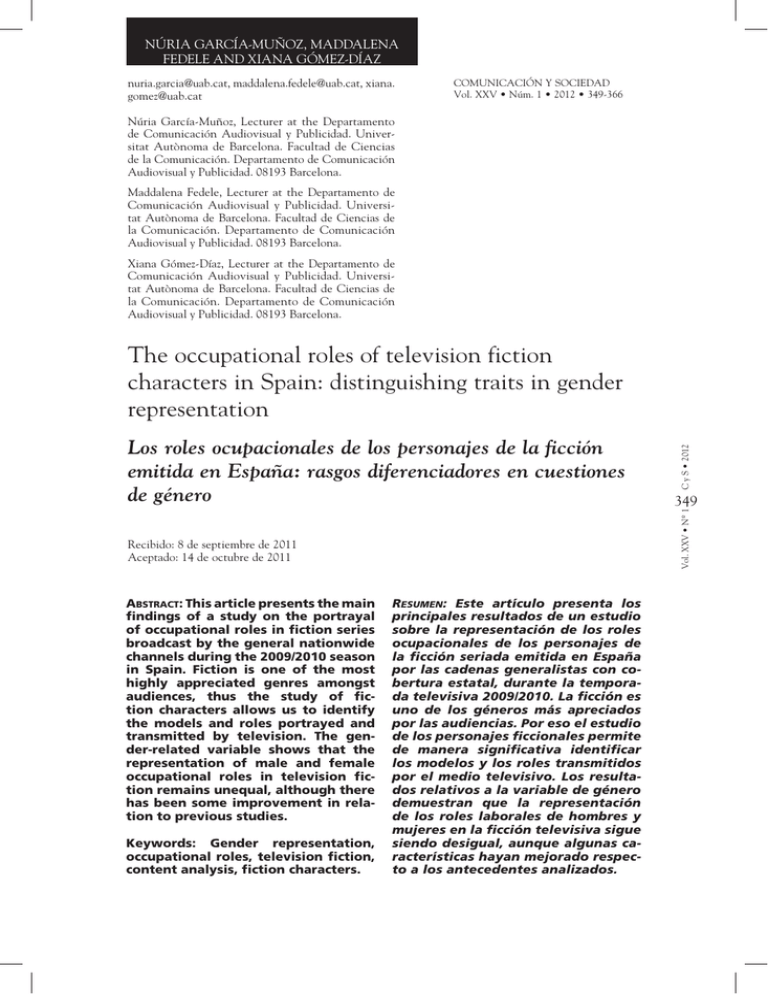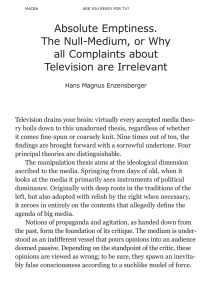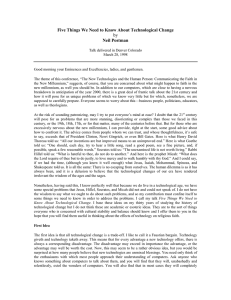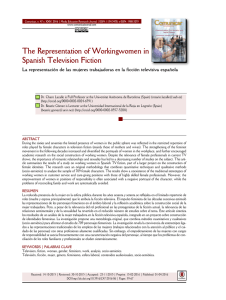The occupational roles of television fiction characters in Spain
Anuncio

núria garcía-muñoz, maddalena fedele and xiana gómez-díaz nuria.garcia@uab.cat, maddalena.fedele@uab.cat, xiana. gomez@uab.cat COMUNICACIÓN Y SOCIEDAD Vol. XXV • Núm. 1 • 2012 • 349-366 Núria García-Muñoz, Lecturer at the Departamento de Comunicación Audiovisual y Publicidad. Universitat Autònoma de Barcelona. Facultad de Ciencias de la Comunicación. Departamento de Comunicación Audiovisual y Publicidad. 08193 Barcelona. Maddalena Fedele, Lecturer at the Departamento de Comunicación Audiovisual y Publicidad. Universitat Autònoma de Barcelona. Facultad de Ciencias de la Comunicación. Departamento de Comunicación Audiovisual y Publicidad. 08193 Barcelona. Xiana Gómez-Díaz, Lecturer at the Departamento de Comunicación Audiovisual y Publicidad. Universitat Autònoma de Barcelona. Facultad de Ciencias de la Comunicación. Departamento de Comunicación Audiovisual y Publicidad. 08193 Barcelona. Recibido: 8 de septiembre de 2011 Aceptado: 14 de octubre de 2011 Abstract: This article presents the main findings of a study on the portrayal of occupational roles in fiction series broadcast by the general nationwide channels during the 2009/2010 season in Spain. Fiction is one of the most highly appreciated genres amongst audiences, thus the study of fiction characters allows us to identify the models and roles portrayed and transmitted by television. The gender-related variable shows that the representation of male and female occupational roles in television fiction remains unequal, although there has been some improvement in relation to previous studies. Keywords: Gender representation, occupational roles, television fiction, content analysis, fiction characters. 349 Vol. XXV • Nº 1 Los roles ocupacionales de los personajes de la ficción emitida en España: rasgos diferenciadores en cuestiones de género C y S • 2012 The occupational roles of television fiction characters in Spain: distinguishing traits in gender representation Resumen: Este artículo presenta los principales resultados de un estudio sobre la representación de los roles ocupacionales de los personajes de la ficción seriada emitida en España por las cadenas generalistas con cobertura estatal, durante la temporada televisiva 2009/2010. La ficción es uno de los géneros más apreciados por las audiencias. Por eso el estudio de los personajes ficcionales permite de manera significativa identificar los modelos y los roles transmitidos por el medio televisivo. Los resultados relativos a la variable de género demuestran que la representación de los roles laborales de hombres y mujeres en la ficción televisiva sigue siendo desigual, aunque algunas características hayan mejorado respecto a los antecedentes analizados. NÚRIA GARCÍA-MUÑOZ, MADDALENA FEDELE AND XIANA GÓMEZ-DÍAZ Palabras clave: representación de género, roles ocupacionales, ficción televisiva, análisis de contenido, personajes de ficción. C y S • 2012 1. Introduction Vol. XXV • Nº 1 350 Television, both in its analogical and the current digital format, is useful as a socialization model. That is why the study of characters in television programmes allows us to detect social and cultural characteristics and specify any possible transformations that may, or may not (as is the case), have taken place. The roles portrayed have been shown to influence the transmission of values and models to audiences1. In this context, fiction is still the main genre favoured by highly varied audience types, and thematic channels offering these contents proliferate2. However, an increase in the number of channels has not gone hand in hand with an increase in content diversity3, a fact that warrants consideration by studies on media content. With regard to fiction, as well as other contents, audiences still choose what series, sitcoms, soap operas and other genres they wish to see, and can watch different seasons of the same product at the same time. Adults are still faithful consumers of fiction series, as have been, and still are, younger audiences towards specific and general television products4. 1 Cfr. Hoffner, Cynthia A. et al., “Socialization to Work in Late Adolescence: The Role of Television and Family”, Journal of Broadcasting & Electronic Media, 52 (2), 2008, pp. 282-302; Signorielli, Nancy, “‘Television and adolescents’ perceptions about work”, Youth & Society, 24, 1993, pp. 314-341; GLASCOCK, Jack, “Gender roles on prime-time network television: Demographics and behaviors”, Journal of Broadcasting & Electronic Media, 45, 2001, pp. 656-669. 2 Cfr. García-Muñoz, Núria, Larrègola, Gemma, “La TDT en Europa. Modelos de Programación”, Telos, 84, 2010, pp. 65-72. 3 Cfr. BUSTAMANTE, Enrique (coord.), Comunicación y cultura en la Era digital. Industrias, mercado y diversidad en España, Gedisa, Barcelona, 2002; PRADO, Emili, DELGADO, Matilde, “La televisión generalista en la era digital: tendencias internacionales de programación”, Telos, 84, 2010, pp. 52-64. 4 Cfr. GARCÍA-MUÑOZ, Núria, FEDELE, Maddalena, “Television Fiction Series Targeted at Young Audience: Plots and Conflicts Portrayed in a Teen Series”, Comunicar, 37, 2011, pp. 133-140. the occupational roles of television fiction characters in spain: distinguishing traits in... It is essential to know the characters in these fiction series in order to determine what kind of socialization models are put forward. The study we present deals with the occupational roles of characters, particularly those in prime-time television programmes broadcast in Spain in 2009/2010. The research project was conducted with the aid of project CSO2009-12822 of the Plan Nacional I+D+I, financed by the Ministerio de Ciencia e Innovación . The aforementioned project was carried out by GRISS (Grupo de Investigación en Imagen, Sonido y Síntesis), in order to find out more about DTT television content. 5 Cfr. Wood, Julia, Gendered lives: communication, gender and culture, Wadsworth, California, 1994. 6 Cfr. Ceulemans, Mieke, Fauconnier, Imagen, papel y condición de la mujer en los medios de comunicación social, UNESCO/Études et documents d’information, París, 1981. 7 Cfr. DEFLEUR, Melvin L., “Occupational roles as portrayed on television”, Public Opinion Quarterly, 28 (1), 1964, pp. 57-74. 8 Cfr. Seggar, John F., Wheeler, Penny, “World of work on TV: Ethnic and sex representation in TV drama”, Journal of Broadcasting & Electronic Media, 17 (2), 1973, pp. 201-214; Baehr, Helen, Dyer, Gillian (eds.), Boxed in: Women and Television, Pandora Press, New York, 1987; Vande Berg, Leah R., Streckfuss, Diane, “Prime-time television’s portrayal of women and the world of work: A demographic profile”, Journal of Broadcasting & Electronic Media, 36, 1992, pp. 195-208; SIGNORIELLI, Nancy, BACUE, Aaron, “Recognition and respect: A content analysis of prime-time television characters across three decades”, Sex Roles, 40 (7-8), 1999, pp. 527-544; Greenberg, Bradley S., Collette, Larry, “The changing faces on TV: A demographic analysis of network television’s new seasons, 1966-1992”, Journal of Broadcasting & Electronic Media, 41, 1997, pp. 1-13; MENÉNDEZ MENÉNDEZ, M. Isabel, “Variables de diferencia en ficción televisiva: cultura, clase y género en Mujeres y Mujeres desesperadas”, in SANGRO, Pedro y PLAZA, Juan F. (eds.), La representación de las mujeres en 351 Vol. XXV • Nº 1 Gender studies and television have focused on analyzing the television message5, and special attention has been paid to information and advertising, but an interest towards fiction arose during the 1970s in the English-speaking world6. Specific research into the occupational roles portrayed on television has generated significant findings in a relatively small number of studies in comparison to other gender-related themes. Almost half a century ago De Fleur7 pointed to the predominance of male characters in work (83,9% were men and some 16.1% women) in a study on the effects of job portrayal on television in children. Later research dealt with occupational divergences between genders, in which most studies concluded that there is a certain tendency to perpetuate traditional roles8. C y S • 2012 1.1. Television and occupational roles NÚRIA GARCÍA-MUÑOZ, MADDALENA FEDELE AND XIANA GÓMEZ-DÍAZ C y S • 2012 In the 1980s Seggar and Wheeler9 noted an increase in female workers in television content, although women mainly took on roles as wives and housewives10. Yet further studies highlighted that female characters were not shown in non-domestic employment, as observed by Signorielli and Bacue11. According to these authors, 40% of female characters did not have a specific job in a study they carried out on the characters in prime-time television series over three decades. Gender occupational roles placed women in blue-collar rather than white-collar jobs12. However, although sexual division of work based on traditional roles13 is still a constant, some studies have revealed that some women do play professional roles, just like men14. Thus some studies revolved around professionally-based series, such as health, teaching and the law, and so on, and analyzed the occupational roles portrayed. Notable studies here include that conducted by Kalisch and Kalisch15 relating to jobs in nursing and medicine, and the analysis performed by Fernandez Morales16 on American medical series. Vol. XXV • Nº 1 352 el cine y la televisión contemporáneos, Laertes, Barcelona, 2010, pp. 199-219; Lauzen, Martha M., Dozier, David M. and Horan, Nora, “Constructing gender stereotypes through social roles in prime-time television”, Journal of Broadcasting & Electronic Media, 52 (2), 2008, pp. 200-214; emons, Pascale, WESTER, Fred and SCHEEPERS, Peer, “‘He Works Outside the Home: She Drinks Coffee and Does the Dishes’. Gender Roles in Fiction Programs on Dutch Television”, Journal of Broascasting & Electronic Media, 54, 2010, pp. 40-53. 9 Cfr. Seggar, John F., Wheeler, Penny, op. cit. 10 Cfr. Baehr, Helen, Dyer, Gillian (eds.), op. cit. 11 Cfr. SIGNORIELLI, Nancy, BACUE, Aaron, op. cit. 12 Cfr. Greenberg, Bradley S., Collette, Larry, op. cit. Cfr. Signorielli, Nancy, Kahlenberg, Susan, “Television’s world of work in the nineties”, Journal of Broadcasting & Electronic Media, 45, 2001, pp. 4-22. 13 Cfr. GALLEGO, Joana, “Los roles de género”, en LÓPEZ, Pilar (ed.), Instituto Oficial de Radio y Televisión, Madrid, 2004. 14 Cfr. Atkin, David, “The evolution of television series addressing single women, 1966-1990”, Journal of Broadcasting & Electronic Media, 35, 1991, pp. 517-523; Elasmar, Michael, Hasegawa, Kazumi and Brain, Mary, “The portrayal of women in U.S. prime time television”, Journal of Broadcasting & Electronic Media, 43(19), 1999, pp. 20-24. 15 Cfr. KALISCH, Philip. A., KALISCH, Beatrice, “Sex-role stereotyping of nurses and physicians on prime-time television: A dichotomy of occupational portrayals”, Sex Roles, 10 (7-8), 1984, pp. 533-553. 16 FERNANDEZ MORALES, Marta, “Dramaturgias televisivas contemporáneas: el género en las series médicas estadounidenses”, in SANGRO, Pedro y PLAZA, Juan F. (eds.), La representación de las mujeres en el cine y la televisión contemporáneos, Laertes, Barcelona, 2010, pp. 199-219. the occupational roles of television fiction characters in spain: distinguishing traits in... Cfr. TEDESCO, Nancy S., “Patterns in prime time”, Journal of communication, vol. 24, nº 2, 1974, pp. 119-124; Signorielli, Nancy, “Marital status in television drama: A case of reduced options”, Journal of Broadcasting, 26(2), 1982, pp. 585-597; GERAGHTY, Christine, Women and soap opera: a study of Prime Time soap, Polity, London, 1991; SIGNORIELLI, Nancy, BACUE, Aaron, op.cit.; Elasmar, Michael, Hasegawa, Kazumi and Brain, Mary, op. cit.; FOUTS, Gregory, BURGGRAF, Kimberly, “Television situation comedies: female body images and verbal reinforcements”, Sex Roles, 40 (5/6), 1999, pp. 473-481; FOUTS, Gregory, BURGGRAF, Kimberly, “Television situation comedies: female weight, male negative comments, and audience reactions”, Sex Role, 42 (9/10), 2000, pp. 925-932; FOUTS, Gregory, VAUGHAN, Kimberly, “Television situation comedies: male weight, negative references, and audience reactions”, Sex Roles, 46 (11/12), 2002, pp. 439-442; GALÁN-FAJARDO, Elena, “Construcción de género y ficción televisiva en España”, Comunicar, 28, 2007, pp. 229236; SCHARRER, Erica, “Tough guys: the portrayal of hypermasculinity and aggression in televised police dramas”, Journal of Broadcasting & Electronic Media, 45 (4), 2001, pp. 615-634; GLASCOCK, Jack, op. cit. 18 Cfr. Fernández-Villanueva, Concepción et al., “Gender Differences in the Representation of Violence on Spanish Television: Should Women be More Violent?”, Sex Roles, 61, 2009, pp. 85-100; García-Muñoz, Núria, Fedele, Maddalena, “The Teen Series and the Young Target. Gender Stereotypes in Television Fiction targeted to Teenagers”. Observatorio (OBS*) Journal, 5 (1), pp. 215-226; GALÁN-FAJARDO, Elena, op. cit.; BELMONTE, Jorge, GUILLAMÓN, Silvia, “Co-educar la mirada contra los estereotipos de género en TV”, Comunicar, 31, 2008, pp. 115-120; Ramajo, Nati et al., “La presencia del adolescente en el prime time televisivo: objeto de interés en informativos, ficción y publicidad”, Sphera Publica, 2008, pp. 191-212; GUARINOS, Virginia, “Fenómenos televisivos ‘teenagers’: prototipias adolescentes en series vistas en España”, Comunicar, 33, 2009, pp. 203-211. 19 Cfr. GARCÍA-MUÑOZ, Núria, MARTÍNEZ, Núria, “La representación positiva de la imagen de las mujeres en los medios”, Comunicar, 32, 2009, pp. 209-214. 353 Vol. XXV • Nº 1 17 C y S • 2012 Fiction broadcast during prime-time has also sparked special interest in several research projects on gender portrayal, both internationally17 as well as in Spain18. The study of occupational roles in television content is important as it reveals specific traits portrayed by the characters which then become models consumed by audiences. These models are important both from the perspective of models for passive audiences and from that of the active role of audiences19. This study shows the findings of the occupational profile of fiction characters from Spanish series, generated from the following research project questions: H1: Most fiction characters in products from this season are portrayed by their occupation rather than other activities, like domestic or family relations. H2: Age is a differentiating feature in the representation of character gender. H3: Professional activity prestige tends to be more closely associated with male than female characters. NÚRIA GARCÍA-MUÑOZ, MADDALENA FEDELE AND XIANA GÓMEZ-DÍAZ C y S • 2012 2. Methodology Vol. XXV • Nº 1 354 The study analyzed the characters in fiction series broadcast on prime-time TV (20,30-22,30) and at night (22,30-0,00) during the 2009/2010 season by the general Spanish TV channels. The sample was gathered from the following channels: TVE1, Antena3, Cuatro, Telecinco and LaSexta and included the following fictional genres, as classified by the Euromonitor: series, serial, sitcom, cartoon series and cartoon serial, but excluded TV movies, miniseries and films. The study analyzed the main characters, that is to say those characters around which the plots develop and that play a central role in them20 and which also appear as such on the official web pages of the series or serials21 from each series. The sample was taken randomly, choosing three typical weeks (Monday to Friday) of television programmes broadcast over the 2009/2010 season: the first in the week of November, 2009; the second in February, 2010 and the third in May, 2010. The sample brought together 31 series and serials, with a total of 318 characters22; these were used to measure13 variables by means of content analysis. At the same time, 11 other variables related to the products analyzed were measured. Thus, the variables used in the study can be grouped into two typologies: – programme-related variables, such as time slot and day of programme, channel and production type, country and continent of production, genre and microgenre, social and occupational field of the series/serial, among others; – character-related variables: gender and age, occupation type, prestige and leadership, among others. 20 Cfr. THOMPSON, Teresa L., ZERBINOS, Eugenia, “Gender roles in animated cartoons. Has the picture changed in 20 years?”, Sex Roles, 32, 1995, pp. 651-673; AUBREY, Jennifer Stevens, HARRISON, Kristen, “The gender-role content of children’s favorite television programs and its links to their gender-related perceptions”, Media Psychology, 6, 2004, pp. 111-146; MASTRO, Dana E., ORTIZ, Michelle, “A Content Analysis of Social Groups in Prime-Time SpanishLanguage Television”, Journal of Broadcasting and Electronic Media, 52(1), 2008, pp. 101-118; ROBINSON, Tom, CALLISTER, Mark and MAGOFFIN, Dawn, “Older Characters in Teen Movies from 1980-2006”, Educational Gerontology, 35(8), 2009, pp. 687-711. 21 Cfr. ROBINSON, Tom, CALLISTER and Mark, JANKOSKI, Tahlea, “Portrayal of body weight on children’s television sitcoms: A content analysis”, Body Image, 5, 2008, pp. 141-151. 22 The high number of characters is due to the presence of numerous group serials, i.e. there is a group of people starring in the series. the occupational roles of television fiction characters in spain: distinguishing traits in... Variables were determined from both our own contributions and those from other authors, among whom we can highlight Signorielli y DeFleur23. Sample collection and data analysis were carried out using the statistic analysis software SPSS, taking the value 0.05 as mean significance level. Frequency tables were obtained for descriptive analysis and contingency tables were built for bivariable analysis. The chi-squared test, the odds ratio test and Fisher’s exact test were used to assess the existence of dependence relations among the variables. Finally, to complement the quantitative statistical treatment, a qualitative analysis of the sample episodes was performed. 23 Cfr. Signorielli, Nancy, “Race and sex in prime time: A look at occupations and occupational prestige”, Mass Communication and Society, 12 (3), 2009, pp. 332-352; DEFLEUR, Melvin L., op. cit. 355 Vol. XXV • Nº 1 As indicated in the section above, the sample brought together 31 fiction series products with a total of 318 characters. Certain characteristics can be described in the fiction products we analyzed. Firstly, there is a predominance of series (61,3%) in comparison to serials (25,8%) and to sitcoms (scarcely 12,9%). In addition, this fictional genre showed greater number of microgenres, including drama, comedy, adventure, science fiction and law enforcement series. In contrast, there were only two microgenres of serials: drama (62,5%) and thriller/suspense (37,5%). Drama series, in particular, comprised the most frequent fictional microgenre (29%), above all police series, which made up 35,5% of the total sample and reached 52,6% when referring exclusively to series genre. The remaining products were divided into the following microgenres: comedy (16,1%), thriller/suspense (9,7%) and science fiction/adventure (9,7%). In addition, programmes of the law enforcement microgenre were only shown by private channels as a series genre, and there was only one police sitcom and no serials of this type. A second point to highlight is the predominance of home-produced fiction (61,3%) in comparison to fiction purchased from the USA (38,7%). In addition, only home-produced series were broadcast in public channels. Among the private networks, Antena3 was also found to wager on home-produced fiction (7 out of 8 shows), followed by Telecinco (6 home-produced and 3 purchased), while Cuatro and laSexta broadcast US fiction. C y S • 2012 3. Sample description C y S • 2012 NÚRIA GARCÍA-MUÑOZ, MADDALENA FEDELE AND XIANA GÓMEZ-DÍAZ Vol. XXV • Nº 1 356 Most series (64,5%) were scheduled in a time period that overlapped with the prime-time and the night time slot. The public channel only opted for this formula, although it was also a characteristic trait of the private channels. These channels also scheduled fiction exclusively at prime-time (9,7%) and at night (25,8%). The series shown at prime-time were usually home-produced comedy series, while those scheduled exclusively at night were generally police series and of the law enforcement microgenre. Fiction was preferably shown on Thursdays (25,8%), Mondays (22,6%), Tuesdays (22,6%) and Wednesdays (19,4%), while other macrogenre programmes channels were usually chosen on Fridays. There were also cases of series and serials scheduled more than one day a week, albeit only a minority (3,2%). The channels that favoured fiction in the time frame analyzed were Telecinco (29% of the total number of series broadcast) and Antena3 (25,8%), followed by Cuatro (19,4%) and TVE1 (16,1%), while LaSexta obtained the lowest number of points, with barely 9,7%. Finally the most highly portrayed social occupation was in police series (35,5%), in comparison to 12,9% in health and 6,5% in education. The most common occupations in the fiction products analyzed (45,2%) were classified as being highly generic. 4. Characters and occupational roles The first point to highlight in the analysis is that work life largely defines the character, although this generalization can be qualified by character gender. This professional dimension of the characters is, in fact, of great interest to programme makers. It defines the aforesaid characters, which are often described through their work activity, as shown by the fact that only 21,6% of the characters do not have any paid non-domestic employment, as can be seen in Table 1. 64,7% of the characters without employment are women and 35,3% men, which indicates that the tendency to portray fictional characters through their job is far less strict with regards women, who are portrayed through their family, home and social relations with greater frequency than men. the occupational roles of television fiction characters in spain: distinguishing traits in... Valid percentage Accumulated percentage Professional 77 24,2 24,2 White collar 46 14,5 38,7 Blue collar 21 6,6 45,3 Law enforcement 84 26,4 71,7 Criminal 5 1,6 73,3 Other 15 4,7 78,0 Not working 68 21,4 99,4 2 ,6 100,0 318 100,0 Unknown Total One of the consequences of the tendency to define characters through their job is the lower interest these programmes have in the social world outside economic or professional activities. Thus, only 9,7% of the different characters in the series in our sample were not people of working age (between 16 and 65). As a result, children and the under-16s, as well as the over-65s, receive very little attention from producers and programme makers in television fiction broadcast in Spain, thereby confirming this study’s first research question (H1: Most fiction characters in products from this season are portrayed by their occupation rather than other activities, like domestic or family relations). There are almost ten deviation points between active characters and gender. This indicates that the job activity is slightly skewed towards males (56,4% of active male characters versus 43,6% women in the same situation). If we look at the non-active population, the gap between both genders is much higher. 72,4% of women form part of the group without employment, in comparison to only 25,8% of male characters in this category. Likewise, those involved in unpaid domestic chores amounts to only 2,8% of the characters in our sample. This niche remains one of the places where gender portrayal shows the greatest segregation between men and women. 88,9% of those occupied in housework without paid employment are women. Students, both in compulsory and higher education, represent 13,5% of the characters in television fiction series in Spain. At the same time, there is also an interesting relationship between gender and age of the characters portrayed in television fiction. It has been shown that there is a tendency to portray younger women than men (Signorielli & Bacue, 1999). This logic operates through a double mechanism: on the one 357 Vol. XXV • Nº 1 Valid Frequency C y S • 2012 Table 1. Character occupation following Signorielli’s classification (2009) C y S • 2012 NÚRIA GARCÍA-MUÑOZ, MADDALENA FEDELE AND XIANA GÓMEZ-DÍAZ Vol. XXV • Nº 1 358 hand, a high number of young women is portrayed in fiction; on the other, older women are excluded from television plots, especially main roles. In our sample of fiction series we found evidence that reaffirms this practice, one which is progressively excluding older women from the imaginary world of television. It is also perpetuating the symbolic couple (professional, social, intimate) formed by a man and a woman, between whom there is a certain difference of age depicted through the combination of “older man-younger woman”. The data in our content analysis (see Table 2, p=0,033) show that in the two lower age ranges in our classification, from 0 to 20 and from 21 to 40 years of age, there is a majority of female characters. From the ages of 0 to 20, there are 55% of women in comparison to 45% of men. Between the ages of 21 and 40 (the largest segment as regards number of characters), the percentage lies at 51% for female characters in comparison to 48,1% for male characters. In addition, 71% of female characters are to be found in these two age categories. In contrast, the higher age segments, which bring together the 41 to 60 year olds, on the one hand, and the 61 to 80 year olds, on the other, are full of male characters. This age gender distribution validates the second research project hypothesis (H2: Age is a differentiating feature in the representation of character gender), thereby confirming that there is still a correlation between the age and gender variables. Table 2. Character age * Character gender GENDER OF CHARACTER FEMALE AGE OF CHARACTER 0-20 Count % of CHARACTER AGE 21-40 Count % of CHARACTER AGE 41-60 Count % of CHARACTER AGE 61-80 Count % of CHARACTER AGE Total Count % of CHARACTER AGE MALE Total MUJER 22 18 40 55,0% 45,0% 100,0% 83 77 160 51,9% 48,1% 100,0% 31 60 91 34,1% 65,9% 100,0% 12 15 27 44,4% 55,6% 100,0% 148 170 318 46,5% 53,5% 100,0% 24 Cfr. SIGNORIELLI, Nancy, “Race and sex in prime time…". 359 Vol. XXV • Nº 1 Of particular significance for this study is the preeminence of male characters between 41 and 60 years of age, given that this age segment shows characters at the top of their professional career. Frequently, characters in this age range hold positions of greater social prestige and strategic leadership. It is thus worrying that the difference in gender portrayal is most unequal in this age range: whereas 65,9% of men are portrayed at this age, only 34,1% of women in our sample are to be found in this demographic segment. This data also tells us there is greater interest in, and social and professional validation of, male characters in the 41 to 60 age range. These characters, in their personal and professional maturity, would therefore seem to arouse greater interest than their female counterparts. In the case of the latter, personal maturity is brought forward a few years and is often associated to sentimental partners who are older, and professional maturity is often simply less important for plot development in television fiction. In the 61-80 range, there are also more men than women (53,5% versus 46,5%). This segment is less highly portrayed in television fiction, comprising 8,5% of the total number of characters. Finally, we must highlight some results relating to the characters’ job prestige. This variable was analyzed using the categories defined by Signorielli24. Characters were observed to be mainly occupied in jobs considered prestigious (39,6%) or neutral (38,7%), while there were very few considered non-prestigious (10,7%) and of unknown prestige or unclassifiable (11%). The prestigious jobs were taken up almost exclusively by characters in the 21- to 40-year-old age range (49,2%) and the 41- to 60-year-old (42,1%), and to a much lesser extent by characters over 60 (8,7%). In particular, it is the 41-60 age range in which most characters (58,2%) perform prestigious jobs. However, the most interesting data were obtained in relation to the gender variable. In this case, a dependence relation was observed between character gender and job prestige (p=0,002). Prestigious occupations, in particular, were more closely associated to male (63,5%) than female characters (36,5%), thereby confirming the third research project question of our study (H3: Professional activity prestige tends to be more closely associated with the male than female characters). On the other hand, female characters mainly held jobs of unknown prestige, comprising 71,4% of the total, in comparison to 28,6% of male ones, while a more equitable gender portrayal was observed in the neutral category. Indeed, if job prestige is distributed by gender, it was observed that women tended to be portrayed mainly in neutral or unknown C y S • 2012 the occupational roles of television fiction characters in spain: distinguishing traits in... NÚRIA GARCÍA-MUÑOZ, MADDALENA FEDELE AND XIANA GÓMEZ-DÍAZ prestige positions (the two categories add up to 58,8% of the total). On the other hand, practically half the men held prestigious jobs. These data are shown in Table 3 (p=0,002). Table 3. Job prestige * Character gender CHARACTER GENDER JOB PRESTIGE (Signorielli, 2009) Prestigious Count % of CHARACTER GENDER Neutral Count % of CHARACTER GENDER C y S • 2012 Non Prestigious Unknown Vol. XXV • Nº 1 360 Count % of CHARACTER GENDER Count % of CHARACTER GENDER Total Count Count % of CHARACTER GENDER Total FEMALE MALE 46 80 126 31,1% 47,1% 39,6% 62 61 123 41,9% 35,9% 38,7% 15 19 34 10,1% 11,2% 10,7% 25 10 35 16,9% 5,9% 11,0% 148 170 318 100,0% 100,0% 100,0% Yet, once again, this data must be qualified, since it varies considerably if it is contextualized by country and product type analyzed. To begin with, US programmes, for instance, tended to portray a greater variety of occupational roles in comparison to Spanish fiction programmes, where a mere 30% of the characters play roles with a prestigious job, versus 62,1% in US fiction series. Having said that, the most relevant results of our study refer to gender portrayal in job prestige and the country where the series or serial was produced, as shown in Table 4. the occupational roles of television fiction characters in spain: distinguishing traits in... Table 4. Job prestige * Character gender * Country of production JOB PRESTIGE Prestigious Count % of CHARACTER GENDER Neutral Count % of CHARACTER GENDER Non Prestigious Unknown Count % of CHARACTER GENDER Count % of CHARACTER GENDER Total Count % of CHARACTER GENDER Spain JOB PRESTIGE Prestigious Count % of CHARACTER GENDER Neutral Count % of CHARACTER GENDER Non Prestigious Unknown Count % of CHARACTER GENDER Count % of CHARACTER GENDER Total Count % of CHARACTER GENDER MALE 23 36 59 63,9% 61,0% 62,1% 11 18 29 30,6% 30,5% 30,5% 0 3 3 0% 5,1% 3,2% 2 2 4 5,6% 3,4% 4,2% 36 59 95 100.0% 100.0% 100,0% 23 44 67 20,5% 39,6% 30,0% 51 43 94 45,5% 38,7% 42,2% 15 16 31 13,4% 14,4% 13,9% 23 8 31 20,5% 7,2% 13,9% 112 111 223 100,0% 100,0% 100,0% C y S • 2012 USA Total FEMALE 361 Vol. XXV • Nº 1 CHARACTER GENDER COUNTRY OF PRODUCTION NÚRIA GARCÍA-MUÑOZ, MADDALENA FEDELE AND XIANA GÓMEZ-DÍAZ In the case of US-produced programmes there is no dependence relation between character gender and job prestige, whereas this relation of dependence was found in the case of Spanish-produced series and serials (p=0,002). As can be seen in Table 4, the percentage of men and women in prestigious or neutral jobs is very similar in US fiction. In addition, there is no woman in a non-prestigious job. In contrast, Spanish products show a much higher percentage of male characters in prestigious jobs than women, while there is a certain amount of equality in the case of non-prestigious jobs. In other words, whereas there is a more equitable portrayal of gender in relation to job prestige in series imported from the USA, Spanish fiction still perpetuates traditional gender stereotypes. C y S • 2012 5. Conclusions Vol. XXV • Nº 1 362 Television fiction has remained a steady favourite among media products for highly diverse audiences25. The study of the imaginary world depicted in these products is highly relevant because of its social significance. Knowing how gender is portrayed in television series provides data that allow us to assess to what extent these audiovisual products influence social reality, and to what extent social changes can brought about by modifying them. This study focused on a survey of the portrayal of gender and occupational roles in television series broadcast in Spain in the 2009-2010 season. A sample of prime-time and night-time fiction was taken from the main channels of the nationwide broadcasting networks. This sample was justified because the aforesaid time slots and channels broadcast a number of series which had an impact on a wide audience and were therefore the most representative products of the studied phenomenon. The study of characters in television fiction pointed to the fact that female characters failed to portray any occupational role26. The review of characters in our sample qualifies this appreciation. In fact, the work life of the characters is a defining characteristic in many cases, as indicated by the fact that only a fifth of the characters in the sample do not hold any paid job. Most unemployed characters were women, a fact that places the series analyzed in this study in line with the work of Signorelli and Bacue27. As in the work of these authors, 25 Cfr. García-Muñoz, Núria, Larrègola, Gema, op. cit. Cfr. SIGNORIELLI, Nancy, BACUE, Aaron, op. cit. 27 Cfr. SIGNORIELLI, Nancy, BACUE, Aaron, op. cit. 26 363 Vol. XXV • Nº 1 this study showed that the link between work and the character in television fiction is much looser for female than male characters. On the other hand, content analysis of the series broadcast in Spain in the 2009-2010 season showed that these products still tended to portray younger female than male models. Most female characters were to be found in the younger age-range categories (0-20 and 21-40), while there was a greater number of male characters in the older age-range categories. These data show that the female models offered to the audience by these products were mainly relatively young women and that there is a progressively lower number of women as the age increased. Values of professionalism and interest (social, family, human) in the case of women were therefore tied to young or relatively young characters, since older women tended to be excluded from the main roles in television series and did not perform any major role in plot development; at most, they made up the human background to the plot. This tendency persisted with male characters, but was delayed two decades: the maturity of the man, in the different spheres of his life, occurred from 40 to 60 years of age, a stage in which the male characters are still of great interest in the fiction. Moreover, the professionals with greatest social prestige (58,2%) were to be found in the age range between 40 and 60, where men represented 65,9% of the total. Generally speaking, it was seen that the relationship between job prestige and character gender has undergone a contradictory evolution. While less prestigious jobs are not always associated with women, the same can be said for more highly prestigious jobs. In this respect, Spanish fiction, unlike US-produced fiction, also deals with the issue of prestige following gender stereotypes. The data of this study show that gender portrayal in television fiction is still unequal. Although progress has been made in the numbers of men and women portrayed in occupational roles in this format, the distribution of characters by ages and job prestige reiterates stereotypes. The social portrait of these series is therefore problematic and it is advisable to learn more about it and discuss it in depth. C y S • 2012 the occupational roles of television fiction characters in spain: distinguishing traits in... NÚRIA GARCÍA-MUÑOZ, MADDALENA FEDELE AND XIANA GÓMEZ-DÍAZ C y S • 2012 References Vol. XXV • Nº 1 364 Atkin, David, “The evolution of television series addressing single women, 1966-1990”, Journal of Broadcasting & Electronic Media, 35, 1991, pp. 517-523. AUBREY, Jennifer Stevens, HARRISON, Kristen, “The gender-role content of children’s favorite television programs and its links to their gender-related perceptions”, Media Psychology, 6, 2004, pp. 111-146. Baehr, Helen, Dyer, Gillian (eds.), Boxed in: Women and Television, Pandora Press, New York, 1987. BELMONTE, Jorge, GUILLAMÓN, Silvia, “Co-educar la mirada contra los estereotipos de género en TV”, Comunicar, 31, 2008, pp. 115-120. BUSTAMANTE, Enrique (coord.), Comunicación y cultura en la Era digital. Industrias, mercado y diversidad en España, Gedisa, Barcelona, 2002. Ceulemans, Mieke, Fauconnier, Imagen, papel y condición de la mujer en los medios de comunicación social, UNESCO/Études et documents d’information, París, 1981. DEFLEUR, Melvin L., “Occupational roles as portrayed on television”, Public Opinion Quarterly, 28 (1), 1964, pp. 57-74. Elasmar, Michael, Hasegawa, Kazumi and Brain, Mary, “The portrayal of women in U.S. prime time television”, Journal of Broadcasting & Electronic Media, 43(19), 1999, pp. 20-24. emons, Pascale, WESTER, Fred and SCHEEPERS, Peer, “‘He Works Outside the Home: She Drinks Coffee and Does the Dishes’. Gender Roles in Fiction Programs on Dutch Television”, Journal of Broascasting & Electronic Media, 54, 2010, pp. 40-53. Fernández-Villanueva, Concepción, et al., “Gender Differences in the Representation of Violence on Spanish Television: Should Women be More Violent?”, Sex Roles, 61, 2009, pp. 85-100. FERNÁNDEZ MORALES, Marta, “Dramaturgias televisivas contemporáneas: el género en las series médicas estadounidenses”, en SANGRO, Pedro, PLAZA, Juan F. (eds.), La representación de las mujeres en el cine y la televisión contemporáneos, Laertes, Barcelona, 2010, pp. 199-219. FOUTS, Gregory, BURGGRAF, Kimberly, “Television situation comedies: female body images and verbal reinforcements”, Sex Roles, 40 (5/6), 1999, pp. 473-481. FOUTS, Gregory, BURGGRAF, Kimberly, “Television situation comedies: female weight, male negative comments, and audience reactions”, Sex Role, 42 (9/10), 2000, pp. 925-932. FOUTS, Gregory, VAUGHAN, Kimberly, “Television situation comedies: male weight, negative references, and audience reactions”, Sex Roles, 46 (11/12), 2002, pp. 439-442. GALÁN-FAJARDO, Elena, “Construcción de género y ficción televisiva en España”, Comunicar, 28, 2007, pp. 229-236. GALLEGO, Joana, “Los roles de género”, en LÓPEZ, Pilar (ed.), Instituto Oficial de Radio y Televisión, Madrid, 2004. GARCÍA-MUÑOZ, Núria, FEDELE, Maddalena, “Television Fiction Series Targeted at Young Audience: Plots and Conflicts Portrayed in a Teen Series”, Comunicar, 37, 2011, pp.133-140. García-Muñoz, Núria, Fedele, Maddalena, “The Teen Series and the Young Target. Gender Stereotypes in Television Fiction targeted to Teenagers”, Observatorio (OBS*) Journal, 5 (1), pp. 215-226. 365 Vol. XXV • Nº 1 García-Muñoz, Núria, Larrègola, Gemma, “La TDT en Europa. Modelos de Programación”, Telos, 84, 2010, pp. 65-72. GARCÍA-MUÑOZ, Núria, MARTÍNEZ, Nuria, “La representación positiva de la imagen de las mujeres en los medios”, Comunicar, 32, 2009, pp. 209-214. GERAGHTY, Christine, Women and soap opera: a study of Prime Time soap, Polity, London, 1991. GLASCOCK, Jack, “Gender roles on prime-time network television: Demographics and behaviors”, Journal of Broadcasting & Electronic Media, 45, 2001, pp. 656-669. Greenberg, Bradley S., Collette, Larry, “The changing faces on TV: A demographic analysis of network television’s new seasons, 1966-1992”, Journal of Broadcasting & Electronic Media, 41, 1997, pp. 1-13. GUARINOS, Virginia, “Fenómenos televisivos ‘teenagers’: prototipias adolescentes en series vistas en España”, Comunicar, 33, 2009, pp. 203-211. Hoffner, Cynthia A., et al., “Socialization to Work in Late Adolescence: The Role of Television and Family”, Journal of Broadcasting & Electronic Media, 52 (2), 2008, pp. 282-302. KALISCH, Philip A., KALISCH, Beatrice, “Sex-role stereotyping of nurses and physicians on prime-time television: A dichotomy of occupational portrayals”, Sex Roles, 10 (7-8), 1984, pp. 533-553. Lauzen, Martha M., Dozier, David M. and Horan, Nora, “Constructing gender stereotypes through social roles in prime-time television”, Journal of Broadcasting & Electronic Media, 52 (2), 2008, pp. 200-214. MASTRO, Dana E., ORTIZ, Michelle, “A Content Analysis of Social Groups in Prime-Time Spanish-Language Television”, Journal of Broadcasting and Electronic Media, 52 (1), 2008, pp. 101-118. MENÉNDEZ MENÉNDEZ, M. Isabel, “Variables de diferencia en ficción televisiva: cultura, clase y género en Mujeres y Mujeres desesperadas”, in SANGRO, Pedro, PLAZA, Juan F. (eds.), La representación de las mujeres en el cine y la televisión contemporáneos, Laertes, Barcelona, 2010, pp. 199-219. PRADO, Emili, DELGADO, Matilde, “La televisión generalista en la era digital: tendencias internacionales de programación”, Telos, 84, 2010, pp. 52-64. Ramajo, Nati et al., “La presencia del adolescente en el prime time televisivo: objeto de interés en informativos, ficción y publicidad”, Sphera Publica, 2008, pp. 191-212. ROBINSON, Tom, CALLISTER, Mark and MAGOFFIN, Dawn, “Older Characters in Teen Movies from 1980-2006”, Educational Gerontology, 35 (8), 2009, pp. 687-711. ROBINSON, Tom, CALLISTER, Mark and JANKOSKI, Tahlea, “Portrayal of body weight on children’s television sitcoms: A content analysis”, Body Image, 5, 2008, pp. 141-151. SCHARRER, Erica, “Tough guys: the portrayal of hypermasculinity and aggression in televised police dramas”, Journal of Broadcasting & Electronic Media, 45 (4), 2001, pp. 615-634. Seggar, John F., Wheeler, Penny, “World of work on TV: Ethnic and sex representation in TV drama”, Journal of Broadcasting & Electronic Media, 17 (2), 1973, pp. 201-214. Signorielli, Nancy, “Race and sex in prime time: A look at occupations and occupational prestige”, Mass Communication and Society, 12 (3), 2009, pp. 332-352. Signorielli, Nancy, “Television and adolescents’ perceptions about work”, Youth & Society, 24, 1993, pp. 314-341. Signorielli, Nancy, “Marital status in television drama: A case of reduced options”, Journal of Broadcasting, 26 (2), 1982, pp. 585–597. C y S • 2012 the occupational roles of television fiction characters in spain: distinguishing traits in... NÚRIA GARCÍA-MUÑOZ, MADDALENA FEDELE AND XIANA GÓMEZ-DÍAZ Signorielli, Nancy, Kahlenberg, Susan, “Television’s world of work in the nineties”, Journal of Broadcasting & Electronic Media, 45, 2001, pp. 4-22. SIGNORIELLI, Nancy, BACUE, Aaron, “Recognition and respect: A content analysis of prime-time television characters across three decades”, Sex Roles, 40 (7-8), 1999, pp. 527544. TEDESCO, Nancy S., “Patterns in prime time”, Journal of communication, vol. 24, nº 2, 1974, pp. 119-124. THOMPSON, Teresa L. and ZERBINOS, Eugenia, “Gender roles in animated cartoons. Has the picture changed in 20 years?”, Sex Roles, 32, 1995, pp. 651-673. Vande Berg, Leah R., Streckfuss, Diane, “Prime-time television’s portrayal of women and the world of work: A demographic profile”, Journal of Broadcasting & Electronic Media, 36, 1992, pp. 195-208. C y S • 2012 Wood, Julia, Gendered lives: communication, gender and culture, Wadsworth, California, 1994. Vol. XXV • Nº 1 366






